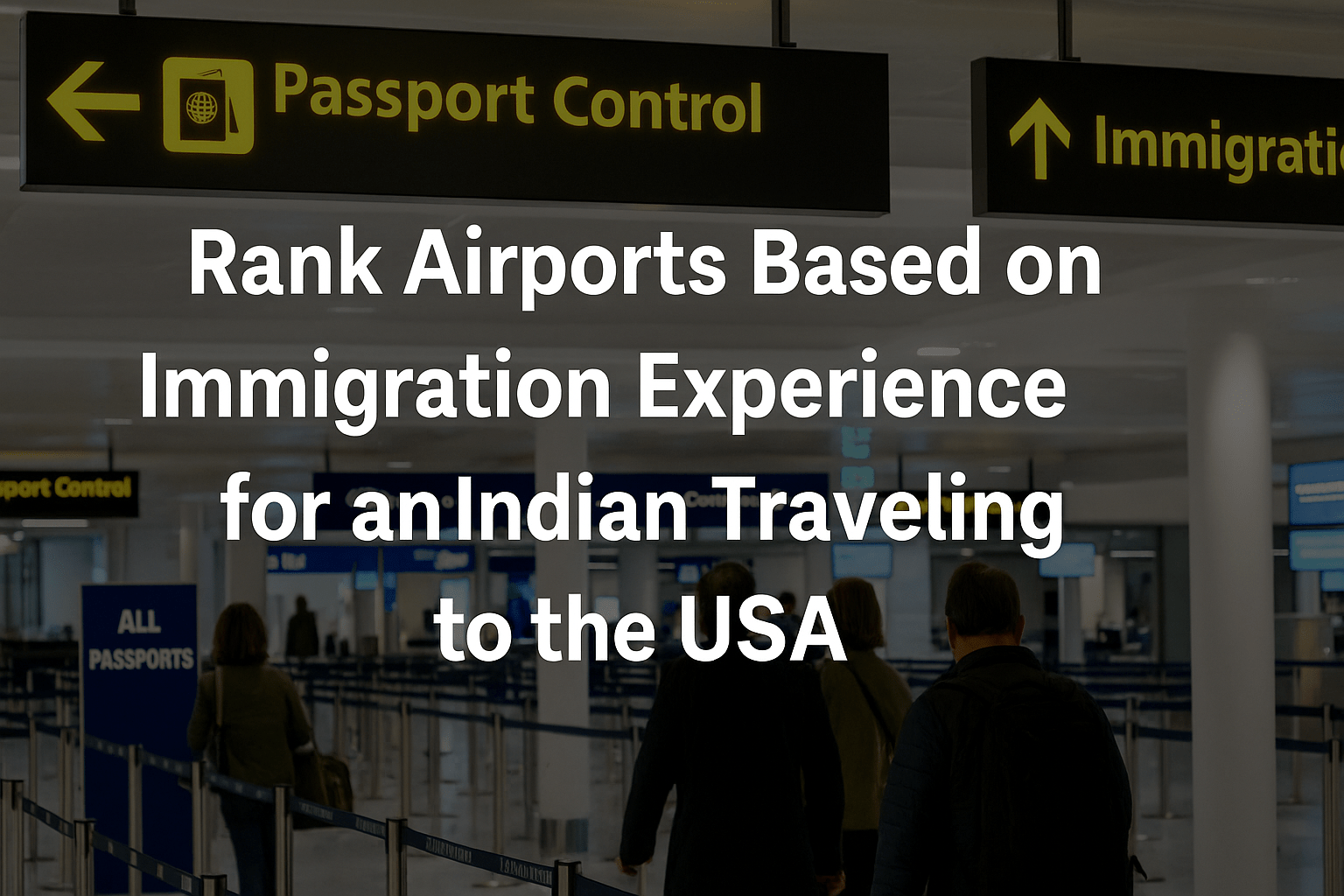Rank Airports Based on Immigration Experience for an Indian Traveling to the USA
Contents
- 1 Rank Airports Based on Immigration Experience for an Indian Traveling to the USA
- 1.1 Introduction
- 1.2 Factors That Impact Immigration Experience
- 1.3 Top Entry Airports in the USA for Indian Travelers
- 1.4 John F. Kennedy International Airport (JFK), New York
- 1.5 Newark Liberty International Airport (EWR), New Jersey
- 1.6 Chicago O’Hare International Airport (ORD)
- 1.7 San Francisco International Airport (SFO)
- 1.8 Los Angeles International Airport (LAX)
- 1.9 Dallas/Fort Worth International Airport (DFW)
- 1.10 Washington Dulles International Airport (IAD)
- 1.11 Atlanta Hartsfield-Jackson International Airport (ATL)
- 1.12 Houston George Bush Intercontinental Airport (IAH)
- 1.13 Seattle-Tacoma International Airport (SEA)
- 1.14 Tips for Smooth Immigration for Indian Travelers
- 1.15 Future of Immigration at US Airports
- 1.16 Conclusion
- 1.17 FAQs
Introduction
Traveling from India to the USA is a long and often emotional journey. For many, the most stressful part is not the 15+ hour flight but the time spent at immigration counters upon arrival. Long queues, stern questioning, and unpredictable delays can leave even the most seasoned traveler exhausted. That’s why ranking airports based on immigration experience matters — because choosing the right arrival hub can make your US entry smoother and less intimidating.
Factors That Impact Immigration Experience
Not every airport handles immigration the same way. Some are efficient and tech-driven, while others can feel overwhelming due to crowd size. Here are the main factors:
-
Processing Time & Wait Duration – Shorter queues and more counters mean quicker clearance.
-
Efficiency of Officers – A friendly officer can reduce stress; an overly strict one can add tension.
-
Technology Use – Airports with e-gates, biometrics, and Mobile Passport apps usually process faster.
-
Language & Cultural Support – Airports with large Indian populations often have staff accustomed to handling Indian travelers.
-
Comfort & Infrastructure – Seating, signs, and waiting areas affect overall experience.
Top Entry Airports in the USA for Indian Travelers
Most Indians enter the USA through 10–12 key airports. Each has its strengths and weaknesses. Below is a ranking-style analysis.
John F. Kennedy International Airport (JFK), New York
-
Why Important?
JFK is one of the busiest airports for Indian flights, especially from Delhi and Mumbai. -
Pros:
-
Large number of immigration counters
-
Staff used to handling Indian travelers
-
Good public transport into New York
-
-
Cons:
-
Long queues during peak hours
-
Can feel chaotic for first-time visitors
-
Verdict: A solid choice for frequent travelers, but first-timers may find it overwhelming.
Newark Liberty International Airport (EWR), New Jersey
-
Why Important?
Located near Edison, NJ — one of the largest Indian communities in the USA. -
Pros:
-
Shorter queues compared to JFK
-
More personalized immigration handling
-
Convenient for Indians with relatives in New Jersey or Pennsylvania
-
-
Cons:
-
Fewer direct flights compared to JFK
-
Facilities slightly older
-
Verdict: Best choice for Indians heading to the East Coast suburbs.
Chicago O’Hare International Airport (ORD)
-
Why Important?
A hub for travelers heading to the Midwest, including large student populations. -
Pros:
-
Immigration usually moves quickly
-
Friendly staff experienced with students
-
-
Cons:
-
Connecting flights can be confusing
-
Airport layout is complex
-
Verdict: Great for Indian students heading to Midwest universities.
San Francisco International Airport (SFO)
-
Why Important?
The Silicon Valley connection makes SFO popular among Indian IT professionals. -
Pros:
-
Technology-driven immigration counters
-
Staff familiar with Indian travelers
-
Global Entry kiosks widely available
-
-
Cons:
-
Can get busy during evening rush
-
Verdict: Best for professionals traveling to California.
Los Angeles International Airport (LAX)
-
Why Important?
Gateway to Hollywood and the US West Coast. -
Pros:
-
Many international counters
-
Good for travelers visiting the South West
-
-
Cons:
-
Known for long waiting times
-
Not beginner-friendly
-
Verdict: Convenient for seasoned travelers but stressful for first-timers.
Dallas/Fort Worth International Airport (DFW)
-
Why Important?
Rapidly growing Indian community in Texas. -
Pros:
-
Spacious terminals
-
Generally shorter wait times than LAX
-
-
Cons:
-
Fewer direct India flights
-
Verdict: Smooth option for travelers heading to Texas.
Washington Dulles International Airport (IAD)
-
Why Important?
Entry point for government, political, and diplomatic visitors. -
Pros:
-
Immigration lines are moderate
-
Staff accustomed to diverse travelers
-
-
Cons:
-
Distance from downtown Washington DC
-
Verdict: Reliable for professionals and diplomats.
Atlanta Hartsfield-Jackson International Airport (ATL)
-
Why Important?
One of the world’s busiest airports. -
Pros:
-
Efficient system for handling crowds
-
Strong infrastructure
-
-
Cons:
-
Can be overwhelming
-
Few direct flights from India
-
Verdict: Good for travelers connecting to southern states.
Houston George Bush Intercontinental Airport (IAH)
-
Why Important?
Popular with South Indian diaspora in Texas. -
Pros:
-
Friendly officers
-
Shorter wait times than other hubs
-
-
Cons:
-
Limited direct flights from India
-
Verdict: Smooth experience if your airline flies here.
Seattle-Tacoma International Airport (SEA)
-
Why Important?
Increasingly popular due to Amazon, Microsoft, and tech firms. -
Pros:
-
Modern immigration counters
-
Staff familiar with Indian tech travelers
-
-
Cons:
-
Limited flight options from India
-
Verdict: Great choice for IT professionals in Washington State.
Tips for Smooth Immigration for Indian Travelers
-
Prepare All Documents – Passport, visa, I-20 (for students), employment letters.
-
Stay Calm During Questions – Officers usually ask simple queries like purpose of visit.
-
Avoid Common Mistakes – Don’t carry restricted food items or give incomplete answers.
-
Use Global Entry / Mobile Passport – Indians on certain visas may qualify for Global Entry.
-
Travel Off-Peak Hours – Early morning or late-night arrivals often mean shorter queues.
Future of Immigration at US Airports
The US is investing in AI-driven biometrics, self-service kiosks, and digital passport apps. Within a few years, immigration could be as quick as scanning your face and walking through — making travel far less stressful.
Conclusion
For Indians traveling to the USA, immigration is the first true test of patience. Airports like Newark (EWR) and San Francisco (SFO) stand out as traveler-friendly, while JFK and LAX can be overwhelming due to heavy traffic. The best choice depends on your destination and comfort level, but preparing well can make any airport experience smoother.
FAQs
1. Which US airport is best for first-time Indian travelers?
Newark (EWR) is often considered best due to shorter queues and a familiar Indian community nearby.
2. Do smaller airports have faster immigration?
Yes, generally smaller airports like Houston (IAH) and Seattle (SEA) process travelers faster.
3. How long does immigration usually take at major airports?
It can range from 30 minutes to 2 hours depending on time of arrival and airport traffic.
4. Can Indians apply for Global Entry?
Yes, as of recent updates, Indian citizens are eligible for Global Entry after background checks.
5. What should Indian students expect during US immigration?
Students are usually asked about their university, course details, and financial support documents.
Disclaimer:
The information provided in this article is for general informational purposes only. While every effort has been made to ensure accuracy, airport immigration procedures and experiences may vary depending on time, location, traveler profile, and policy changes. This content does not constitute legal or travel advice, and readers are encouraged to verify requirements with official authorities or their airline before traveling. The author and publisher assume no responsibility for any losses, delays, or issues arising from reliance on the information provided herein.

























